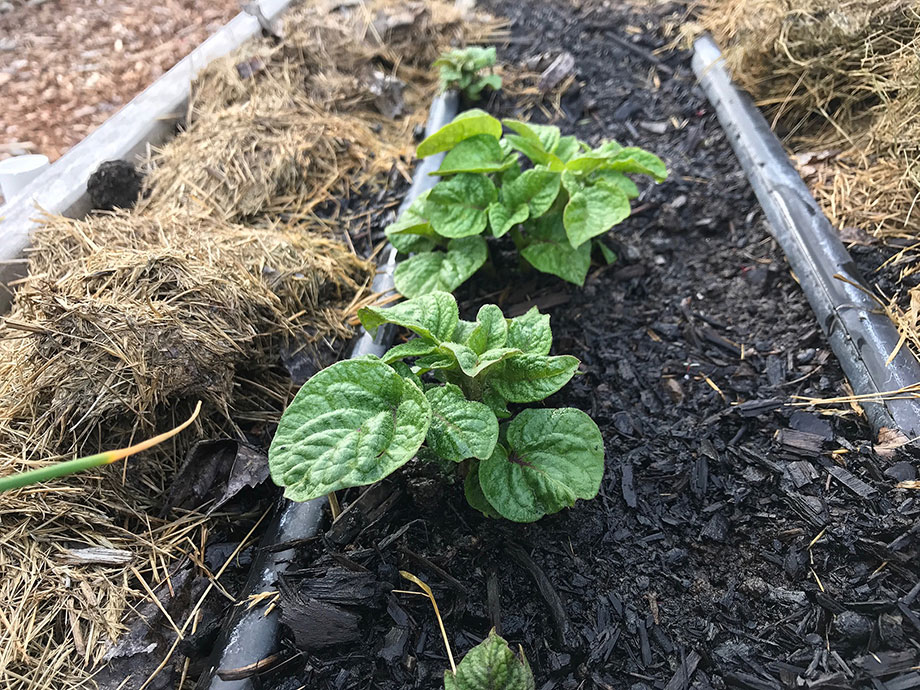May 15 Column: Water Conservation

For my garden column, I wrote about the importance of water conservation in our landscapes. No matter where you live, it’s so important that we all do what we can to preserve this precious resource. You can read my column in today’s edition of The Spokesman-Review: Water conservation – be wise with your landscape . Or you can read the text of my column underneath the video below.
Here in Spokane, our city’s Water Wise Department is offering a lot of rebates and incentives. They are for either installing water usage monitoring devices or changing a landscape to one that is more drought-tolerant. If you are reading this from another part of the country, I encourage you to with your local government to see what types of water conservation incentives they offer.
If you’re wondering what that eye-catching flower is at the very top of this post, it’s Achillea (yarrow) ‘Paprika’. This is a great example of a drought-tolerant perennial.
In this week’s video, I decided to give an update on how our vegetable garden is doing. I typically do a “virtual tour” of the garden once a month and May is a good time to start! It doesn’t look all that impressive yet, though, because a) it’s still early in the season and b) our weather is still quite chilly. I hope you’ll enjoy it:
Here is my column:
by Susan Mulvihill
Now that we’re off and running with a new garden season, it’s a good time to be thinking of ways to conserve water. I have written about this important topic in the past but I believe we all need reminders to develop good habits.
We’re so used to turning on the faucet and being instantly rewarded with water, yet it is a precious, finite resource. As our population continues to grow, we are putting too many demands on the Spokane aquifer, which in turn jeopardizes the health of the Spokane River that plays such an important role in our region.
Water conservation methods
Let’s start by looking for ways to decrease the water consumption within our landscapes.
I know we all love big, green lawns but they are water guzzlers. If you mow your lawn less frequently and set your mower deck at a higher level, the taller grass will shade the roots and conserve the moisture within them. Instead of bagging the clippings, leave them on top of the lawn. This is called “grass-cycling.” As the clippings break down, they’ll feed the turf which means you won’t have to pay to fertilize it.
If you don’t use herbicides on your lawn, you also can use those clippings to mulch your vegetable and flower beds. They will help conserve moisture in the soil and make it difficult for weed seeds to germinate.
To be honest, lawns offer minimal habitat for insect life yet require so many inputs. Consider reducing the size of your lawn and replacing it with flower and shrub beds. They require less water and the flowers will attract pollinators and other beneficial insects.
Three years ago, we removed quite a bit of our front lawn and replaced it with a pollinator garden that is packed with all sorts of wonderful flowers. Throughout the spring, summer and into fall, it is a glorious place that buzzes with activity.
Tools for water conservation
Drip irrigation and soaker hoses are the best watering systems for vegetable gardens and landscape beds. They deliver water to the soil surface where plant roots can easily access it, with minimal evaporation. If you hand-water your garden, remember to water the soil, not the plants. While it’s very helpful to have irrigation systems on timers, watch the weather forecasts. If it’s going to rain, turn off the timer and skip the next watering or two.
Focus on adding more drought-tolerant plants to your landscape. If that conjures up images of groupings of cactus, think again. There are so many wonderful plant options that are beautiful and go easy on the water. Some of my favorites include hummingbird mint (Agastache), blanket flower (Gaillardia), purple coneflower (Echinacea), Russian sage (Perovskia), stonecrop (sedum), yarrow (Achillea), beardtongue (penstemon) and ornamental grasses.
Did you know that Spokane’s Water Wise program offers rebates and other incentives to city homeowners when they install water-saving devices or change to a landscape design that uses less water? This includes implementing “smart” water monitors that track water usage and detect leaks, converting from sprinklers to a drip irrigation system, or replacing your lawn with drought-tolerant plants and mulch. Learn more about these programs by going to my.spokanecity.org/publicworks/water/water-wise-spokane/rebates/, emailing waterwise@spokanecity.org or calling (509) 625-7800.
Whether or not we receive financial incentives for making changes such as those listed above, now is the time to start cutting back on the amount of water we use. Each us of can make a difference; we just need to take that first step.
Susan Mulvihill is author of “The Vegetable Garden Pest Handbook.” She can be reached at Susan@SusansintheGarden.com. Watch this week’s video at youtube.com/susansinthegarden.

